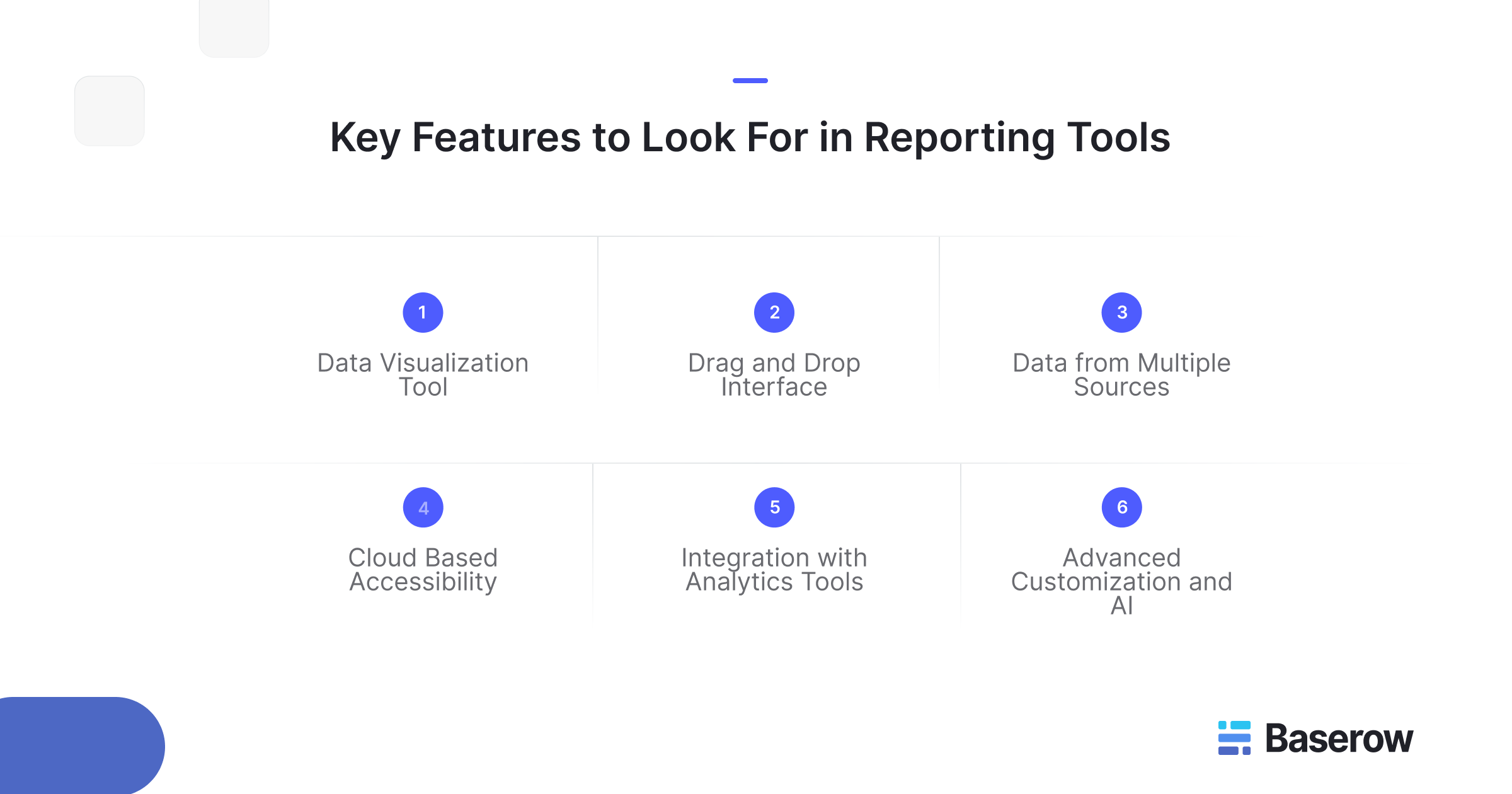
In the modern data economy, the ability to transform complex information into clear, actionable insights is essential for success. Reporting tools play a critical role in this transformation — helping businesses analyze, visualize, and share insights that drive strategic decisions. As organizations handle increasing amounts of data, having reliable and flexible platforms that simplify report generation and collaboration becomes indispensable.
Data-driven teams no longer rely solely on spreadsheets or manual reporting. Instead, they seek solutions that provide real time analytics, dynamic data visualizations, and easy access to data from multiple sources. These tools empower every team member to make informed, data driven decisions without relying on IT or data science teams for constant support.
This is where platforms like Baserow come into play. As a no-code, cloud based reporting and database solution, Baserow allows teams to collect, organize, and analyze data through customizable tables and dashboards. Its flexibility enables companies to create tailored workflows that adapt perfectly to their reporting needs, no matter the size of the business.
What is a Reporting Tool?
A reporting tool is a software application designed to analyze data and present it in an easy-to-understand format through tables, charts, or dashboards. It acts as the bridge between raw data and actionable insight. By enabling visual representation of key metrics, teams can monitor performance, identify patterns, and make quicker strategic decisions.
Unlike static spreadsheets, modern analytics and reporting tools can connect to multiple databases, APIs, and applications to fetch data from multiple sources in real time. They automatically generate and refresh reports — eliminating manual data entry and ensuring that teams always have access to up-to-date information.
Moreover, reporting tools support collaboration across departments. Marketing, sales, and operations can view the same insights through a unified dashboard, improving alignment and transparency. For teams using Baserow, for example, this integration happens effortlessly through shared views, filtered tables, and customizable reporting templates that match the organization’s structure.
If you’re interested in learning how these tools fit into the broader business intelligence landscape, you can also explore The Best Business Intelligence Tools for a more comprehensive overview.

Types of Reporting Tools
Different teams have unique data needs — and therefore, different types of reporting tools serve specific purposes. Broadly, reporting tools can be categorized into three main types:
1. Operational Reporting Tools
Operational reporting focuses on day-to-day metrics and tasks. These tools provide real time insights into daily performance indicators such as sales transactions, customer service metrics, or production outputs. They are essential for monitoring immediate operational efficiency and quickly addressing anomalies.
2. Analytical Reporting Tools
Analytical tools delve deeper into trends, patterns, and predictions. By combining historical and current data, these solutions help teams perform deeper data visualizations and trend analysis. They are ideal for identifying opportunities for growth, cost optimization, or process improvement. For example, Power BI offers robust analytical capabilities with interactive dashboards and AI-assisted forecasting.
3. Strategic Reporting Tools
Strategic reporting focuses on the big picture. These tools combine insights from multiple departments to guide leadership decisions and long-term planning. They rely heavily on data driven decisions and consolidated metrics to align business goals across the organization.
While Excel has traditionally been used for reporting, it lacks the automation, scalability, and collaboration offered by modern tools. Platforms like Zoho Analytics and Baserow offer automated updates, built-in templates, and seamless team sharing — making report creation and distribution much more efficient.
Top Reporting Tools for Data-Driven Teams
Choosing the right reporting solution depends on your team’s workflow, integration needs, and scalability goals. Below are some of the most trusted platforms that help organizations visualize and manage their data effectively.
1. Baserow
Baserow stands out as a no-code, open-source platform that gives teams full control over their data. It empowers users to design custom databases, dashboards, and reports through an intuitive interface — no technical expertise required.
What makes Baserow particularly powerful is its flexibility. You can integrate data from multiple sources, automate report generation, and customize tables with filters, sorting, and formula fields. Teams use Baserow to manage marketing analytics, project tracking, and customer data — all in one collaborative, cloud based environment.
In the Baserow Community, users frequently share use cases where Baserow replaced traditional spreadsheet reporting. One marketing agency, for instance, created a unified dashboard to monitor campaign KPIs across platforms like Google Ads and LinkedIn — reducing manual reporting time by over 60%.
(Also explore Best Collaboration Software Tools to understand how seamless teamwork enhances reporting efficiency.)
2. Power BI
Developed by Microsoft, Power BI is a robust business intelligence and data visualization tool widely used by enterprises. It offers AI-assisted analytics, predictive modeling, and dynamic dashboards. Teams can create complex visuals, share insights through Microsoft Teams, and schedule automatic refreshes for real time reporting.
Power BI is especially suitable for organizations that already use the Microsoft ecosystem. However, it may require technical expertise for advanced configurations — which makes no-code platforms like Baserow a more accessible alternative for smaller teams.
3. Zoho Analytics
Zoho Analytics is a popular cloud based analytics and reporting solution known for its affordability and integration flexibility. It allows users to pull data from over 250 sources, including Google Workspace, CRMs, and accounting tools. The platform also uses artificial intelligence for natural language queries — enabling users to type questions like “Show me this quarter’s revenue by region” and instantly receive a chart.
This makes Zoho Analytics a great option for small to mid-sized businesses seeking automation without the complexity of enterprise-grade software.
4. Tableau
Tableau remains a leading name in the field of data visualizations and dashboard design. It’s ideal for large organizations that require in-depth analysis and visual representation of massive datasets. Tableau supports advanced features like predictive modeling, AI-driven insights, and seamless integration with cloud data warehouses.
However, Tableau’s learning curve can be steep — which is why tools like Baserow are gaining attention for providing customizable, accessible, and collaborative alternatives.
5. Google Data Studio (Looker Studio)
Google Data Studio — now known as Looker Studio — provides free and powerful reporting for Google ecosystem users. It allows integration across multiple data sources, such as Google Analytics, Ads, and Sheets. With drag-and-drop functionality and real-time sharing, teams can create visually appealing dashboards in minutes.
Although it’s user-friendly and cost-effective, it offers limited customization for more complex datasets compared to full-scale tools like Power BI or Baserow.
Why Baserow is the Ideal Reporting Tool for Modern Teams
Baserow’s value lies in its combination of flexibility, collaboration, and simplicity. It enables teams to move beyond traditional spreadsheets without requiring developers or data engineers.
Use Case Example:
A product management team at a SaaS startup struggled to unify performance data across marketing, development, and customer support. Using Baserow, they created a centralized dashboard that connected data from multiple sources, automated report generation, and displayed interactive data visualizations for leadership meetings.
With Baserow’s drag and drop design, the team quickly customized views, filters, and summaries to suit different stakeholders. Its open-source nature also ensured data privacy and scalability as the amount of data grew.
Compared to other tools, Baserow bridges the gap between accessibility and customization — allowing teams to scale their analytics and reporting without dependency on complex software setups.
.jpg)
To explore how it fits within wider tool ecosystems, you can also check Top 10 Project Management Tools that integrate perfectly with reporting workflows.
Frequently Asked Questions
- What is a reporting tool?
A reporting tool helps users collect, organize, and visualize data to make informed decisions. It converts raw data into readable formats like charts or dashboards for clarity and insight.
- What are the three types of reporting tools?
The three main types of reporting tools are operational (daily tracking), analytical (trend analysis), and strategic (executive overviews). Each serves a different business purpose.
- Which is the best reporting tool?
The best tool depends on your organization’s goals. Enterprise teams often prefer Power BI or Tableau, while no-code solutions like Baserow are ideal for flexible, collaborative reporting.
- Is Excel a reporting tool?
Yes, Excel can serve as a basic reporting platform. However, modern tools like Zoho Analytics or Baserow offer automation, integrations, and scalability that Excel lacks.
- What are the three types of reports?
Reports typically fall into summary, analytical, and operational categories — helping users understand performance, identify patterns, and act strategically.
Final Thoughts
Modern teams succeed when they can visualize, interpret, and share insights efficiently. Whether you’re tracking sales, campaigns, or operations, selecting the right platform ensures your team stays aligned and data-driven.
Tools like Baserow redefine reporting by offering an open, collaborative, and no-code environment for any team size. It’s not just about creating reports — it’s about empowering every member to contribute to smarter, faster decision-making.
Ready to experience smarter reporting?
Start creating custom reports with Baserow — the open-source, no-code platform designed to help data-driven teams collaborate with clarity and confidence.

Baserow 2.0 introduces the automations builder, upgraded AI fields, the Kuma AI assistant, enhanced workflow logic with formulas and variables, improved workspace search, and stronger security with 2FA.

Discover how Airtable and Baserow compare in features, flexibility, speed, and scalability. Compare pricing plans and hidden costs to make an informed decision!

Explore the best open-source software alternatives to proprietary products. Discover OSS tools, licenses, and use cases with our updated directory.
